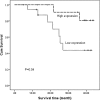Methylation and expression of PTPN22 in esophageal squamous cell carcinoma
- PMID: 27613842
- PMCID: PMC5325424
- DOI: 10.18632/oncotarget.11581
Methylation and expression of PTPN22 in esophageal squamous cell carcinoma
Abstract
Esophageal squamous cell carcinoma (ESCC) is a fatal disease contributed by both genetic and epigenetic factors. The epigenetic alteration of protein tyrosine phosphatase non-receptor type 22 (PTPN22) and its clinical significance in ESCC were still not yet clarified. A quantitative methylation study of PTPN22 and its expression were conducted in 121 and 31 paired tumor and adjacent normal tissue (ANT), respectively. Moreover, the association between PTPN22 methylation and clinicopathological parameters was evaluated. We found that the methylation level of PTPN22 was significantly elevated in tumor tissues (66.3%) relative to ANT (62.1%) (p=0.005). The methylation level of non-smoking ANT (59.1%) was significant lower than smoking ESCC tissue (65.8%) (p=0.03); similarly, the methylation levels in ANT with no lymph node invasion (57.6%) were significant lower than tumor tissues with lymph node invasion (67.5%) (p=0.001). PTPN22 expression in ESCC was lower than normal tissues, however the difference was not statistically significant (p=0.55). Lower expression was more frequently occurred in N1-3 and III stage patients, while higher expression was more likely to occur in N0 and I-II stage patients. Lower expression of PTPN22 was associated with poor overall survival (p=0.04). Taken together, PTPN22 was hypermethylationed in ESCC. Hypermethylation was associated with lymph node invasion. The PTPN22 expression may act as a prognostic biomarker to identify patients at risk of high grade.
Keywords: ESCC; PTPN22; expression; methylation; prognosis.
Conflict of interest statement
The authors declare no conflicts of interests.
Figures




Similar articles
-
Aberrant methylation-mediated silencing of lncRNA CTC-276P9.1 is associated with malignant progression of esophageal squamous cell carcinoma.Clin Exp Metastasis. 2018 Feb;35(1-2):53-68. doi: 10.1007/s10585-018-9881-2. Epub 2018 Mar 10. Clin Exp Metastasis. 2018. PMID: 29524086
-
Prognostic CpG methylation biomarkers identified by methylation array in esophageal squamous cell carcinoma patients.Int J Med Sci. 2014 May 30;11(8):779-87. doi: 10.7150/ijms.7405. eCollection 2014. Int J Med Sci. 2014. PMID: 24936140 Free PMC article.
-
Methylation-mediated repression of potential tumor suppressor miR-203a and miR-203b contributes to esophageal squamous cell carcinoma development.Tumour Biol. 2016 Apr;37(4):5621-32. doi: 10.1007/s13277-015-4432-9. Epub 2015 Nov 17. Tumour Biol. 2016. PMID: 26577858
-
Promoter methylation of tumor suppressor genes in esophageal squamous cell carcinoma.Chin J Cancer. 2013 Jan;32(1):3-11. doi: 10.5732/cjc.011.10381. Epub 2012 May 8. Chin J Cancer. 2013. PMID: 22572016 Free PMC article. Review.
-
Aberrant DNA Methylation in Esophageal Squamous Cell Carcinoma: Biological and Clinical Implications.Front Oncol. 2020 Oct 23;10:549850. doi: 10.3389/fonc.2020.549850. eCollection 2020. Front Oncol. 2020. PMID: 33194605 Free PMC article. Review.
Cited by
-
Genome-wide DNA methylation profile identified a unique set of differentially methylated immune genes in oral squamous cell carcinoma patients in India.Clin Epigenetics. 2017 Feb 3;9:13. doi: 10.1186/s13148-017-0314-x. eCollection 2017. Clin Epigenetics. 2017. PMID: 28174608 Free PMC article.
-
Genomic and Epigenomic Aberrations in Esophageal Squamous Cell Carcinoma and Implications for Patients.Gastroenterology. 2018 Jan;154(2):374-389. doi: 10.1053/j.gastro.2017.06.066. Epub 2017 Jul 27. Gastroenterology. 2018. PMID: 28757263 Free PMC article. Review.
-
The impact of phosphatases on proliferative and survival signaling in cancer.Cell Mol Life Sci. 2018 Aug;75(15):2695-2718. doi: 10.1007/s00018-018-2826-8. Epub 2018 May 3. Cell Mol Life Sci. 2018. PMID: 29725697 Free PMC article. Review.
-
A comprehensive methylation signature identifies lymph node metastasis in esophageal squamous cell carcinoma.Int J Cancer. 2019 Mar 1;144(5):1160-1169. doi: 10.1002/ijc.31755. Epub 2018 Oct 16. Int J Cancer. 2019. PMID: 30006931 Free PMC article.
-
Transethnic associations among immune-mediated diseases and single-nucleotide polymorphisms of the aryl hydrocarbon response gene ARNT and the PTPN22 immune regulatory gene.J Autoimmun. 2020 Feb;107:102363. doi: 10.1016/j.jaut.2019.102363. Epub 2019 Nov 21. J Autoimmun. 2020. PMID: 31759816 Free PMC article.
References
-
- Jemal A, Bray F, Center MM, Ferlay J, Ward E, Forman D. Global cancer statistics. CA Cancer J Clin. 2011;61:69–90. - PubMed
-
- Torre LA, Bray F, Siegel RL, Ferlay J, Lortet-Tieulent J, Jemal A. Global cancer statistics, 2012. CA Cancer J Clin. 2015;65:87–108. - PubMed
-
- Wang JD, Ma J, Wang FY, Peng LB, Wang X, Shi SS, Ma HH, Lu ZF, Lu GM, Zhou XJ. Amplification of the telomerase RNA component gene as a new genetic marker for disease progression and prognosis in esophageal squamous cell carcinoma. Dis Esophagus. 2013;26:737–45. - PubMed
-
- Dong Z, Guo W, Guo Y, Kuang G, Yang Z. Concordant promoter methylation of transforming growth factor-beta receptor types I and II occurs early in esophageal squamous cell carcinoma. Am J Med Sci. 2012;343:375–81. - PubMed
-
- Das PM, Singal R. DNA methylation and cancer. J Clin Oncol. 2004;22:4632–42. - PubMed
MeSH terms
Substances
LinkOut - more resources
Full Text Sources
Other Literature Sources
Medical

